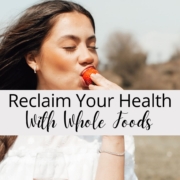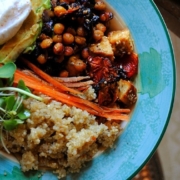Choose Your Food From Plants
 Where do the foods you eat come from? No, I’m not meaning where you bought them, or how they were packaged. I mean what was the original source?
Where do the foods you eat come from? No, I’m not meaning where you bought them, or how they were packaged. I mean what was the original source?
Most Americans eat white potatoes and corn in various forms and think they are eating their vegetables. But there is very little nutrient offered in them, and corn isn’t even a vegetable … it’s a grain. Pass on these and focus on putting color on your plate, along with protein from non-meat sources.
When someone encourages you to eat fresh veggies, you probably think of a salad. While salads are a great way to get a variety of fresh, colorful fruits and vegetables, they can get old after a while. Let’s look at some additional ways to add more plants to benefit your body.
Nuts and seeds – can be consumed for snacks or added to yogurt, salads or oatmeal. Nuts are rich in protein, vitamins, minerals and healthy fats, while seeds are a great source of vitamins, minerals and fiber. Snacking on an ounce of nuts can help with overall appetite control during the day and thereby weight management.
Avocados – can be added in a variety of ways. These creamy fruits can be used in place of cheese, or added to a smoothie to give it the consistency of a milkshake. I’ve blended an avocado with Greek yogurt to use in place of mayo for chicken salad, or diced it directly into a salad. Be creative in the ways you include it and you will be adding healthy fat, fiber and potassium.
Roasted vegetables – have a rich and robust flavor, and can be enjoyed hot or cold. Choose from broccoli, cauliflower, Brussels sprouts, beets, carrots, peppers, parsnips and sweet potatoes. Put them together in a beautiful rainbow collection to make them appealing to the eye as well as the taste buds.
Beans – there are so many kinds of beans that you’ll never get bored. They are rich in folate, fiber and protein. They are an easy addition to your meal – open a can, rinse the beans and add them to your entree, soup or salad. For a more economical approach, buy the beans dry, cook them and then use them in several meals. Lentils cook quickly and can be combined with some salsa and chopped avocado for a quick, satisfying meal. Garbanzos, or chickpeas, can be added to a salad as a protein source, or made into hummus. Yum!
Mushrooms – could be considered a chameleon food. They can be a stand-alone vegetable, or blended into a wide variety of dishes. They are meaty, filling and bursting with nutrition such as B vitamins, selenium, antioxidants, potassium, copper and vitamin D to support healthy skin, bones and blood pressure, and boost your energy and immune system.
Step out of the average American profile of eating 2 or fewer servings of vegetables a day. Find new ways to add vegetables, beans, nuts and seeds to improve your culinary nutritional profile. There’s plenty of room for improvement and your body will reward you!
Go to the Pursue Wellness Facebook page and let me know what you try … and how you feel as a result.



Thank you for your encouraging comments!
And then you have the people who put so much driessng on their salad that they might as well have a couple of slices of pizza. I feel kind of bad when I see someone who has good intentions just dousing a salad with driessng. It’s as if they blocked out all the talk shows, magazines and newspaper items showing how heavily dressed salads stack up.
Agreed, Deni! Dressing is not the primary aspect of a salad, unbeknownst to many restaurants and consumers.